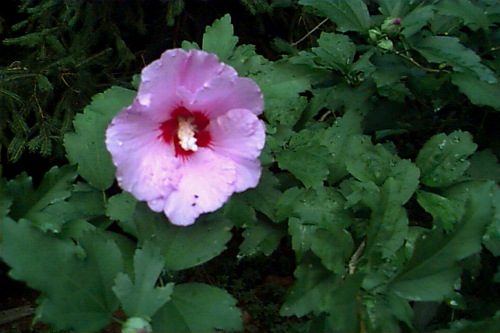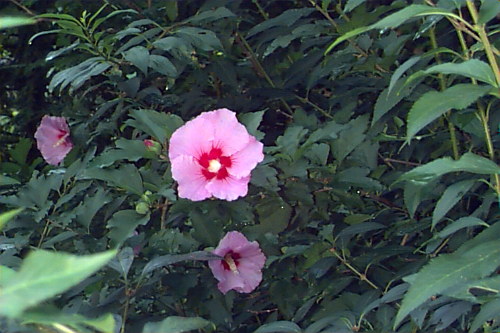Hibiscus syriacus
Rose-of-sharon, Shrub Althea
Malvaceae
ExpandHabitat
- native to China and India
- hardy to zone 5
- Special Note: This species has demonstrated an invasive tendency in Connecticut, meaning it may escape from cultivation and naturalize in minimally managed areas. For more information, .
Habit and Form
- a deciduous, flowering shrub
- 8' to 10' tall
- 6' to 8' wide
- upright, spreading branching
- develops a vase-shaped outline
- often leggy at the base
- multi-stemmed with lots of vertical branches
Summer Foliage
- alternate, simple, deciduous leaves
- leaves 3-lobed
- margins coarsely toothed
- 2" to 4" long
- medium to dark green
- leaf surface glabrous sometimes shiny
- late to leaf out in spring
Autumn Foliage
- yellow-green
- leave hold late
- overall poor effect
Flowers
- large, showy blossoms in July, August, and September
- white, pink, magenta, violet, blue, and combinations of these
- 5-petaled
- 2" to 4" across
- single or double
- flowers are solitary
- produced on current season's growth
Fruit
- a brown capsule
- 0.75" long
- persists through the winter
- 5-valved
Bark
- light gray
Culture
- full sun is best, but tolerant of partial shade
- soils are not critical
- easily transplanted
- annual pruning back will result in increases shoot vigor and larger flowers
- likes hot weather
- may need to remove winter killed stems
Landscape Use
- shrub border
- screen
- groupings and mass plantings
- useful for late season bloom
- do not use as a specimen plant
- standard forms may be used as small trees
Liabilities
- does not have multi-season ornamental appeal
- winter injury and twig dieback
- late to leaf out in spring
- leaf spot, cankers, rust, aphids, spider mites
ID Features
- 3-lobed leaves
- late summer large flowers
- distinctive vase-shaped habit
- persistent 5-valved capsules
- indistinct buds
- shelf-like projections mark the position of previous flowers and fruit
- thread-like stipules are persistent
Propagation
- by cuttings
- by seed
Cultivars/Varieties
Dozens of forms are available, but the following listing encompasses cultivars that indicate the range of types offered.
'Aphrodite' - This U.S. National Arboretum introduction features dark pink flowers exhibiting a dark red eyespot. The foliage is heavily textured. As this plant is a triploid, it should not produce as many seedlings. Some observations indicate ample seed production.
'Ardens', 'Blushing Bride' and 'Peoniflora' - These cultivars are just a few of the many forms sold at nurseries with double blooms of a pink or rose hue.
'Blue Bird' (also listed as 'Bluebird') - A form with single flowers that are a blue with a reddish base, this old form is still popular in the trade.
'Diana' - This triploid U.S. National Arboretum introduction is one of the best white-flowered forms. The blooms are large and lack a central blotch. They remain open at night and are produced over a long period due to little or no seed production. This plant appears to be less vigorous than other forms.
'Helene' - A triploid form producing white flowers that are maroon at the base, this U.S. National Arboretum introduction flowers heaviliy and sets little fruit.
'Minerva' - A heavy-blooming cultivar with lavender flowers overcast with some pink, this plant remains smaller and more shrubby (to 9' tall). The flowers have a red eye and the foliage is higher quality than the species. A U.S. National Arboretum introduction reportedly performing well into USDA zone 5.
'Pink Giant' - This form bears large, 5" wide pink blooms with a deep red central blotch. It grows 8' tall and wide.
'Purpureus Variegatus' and 'Meehanii' - These are two of the more common variegated forms, featuring leaves variously edged or mottled with white, yellow, and gray. The flowers are of secondary interest on these plants.
'Tri-color' - This is a very unusual cultivar with double flowers colored pink, red and purple on one plant.
























